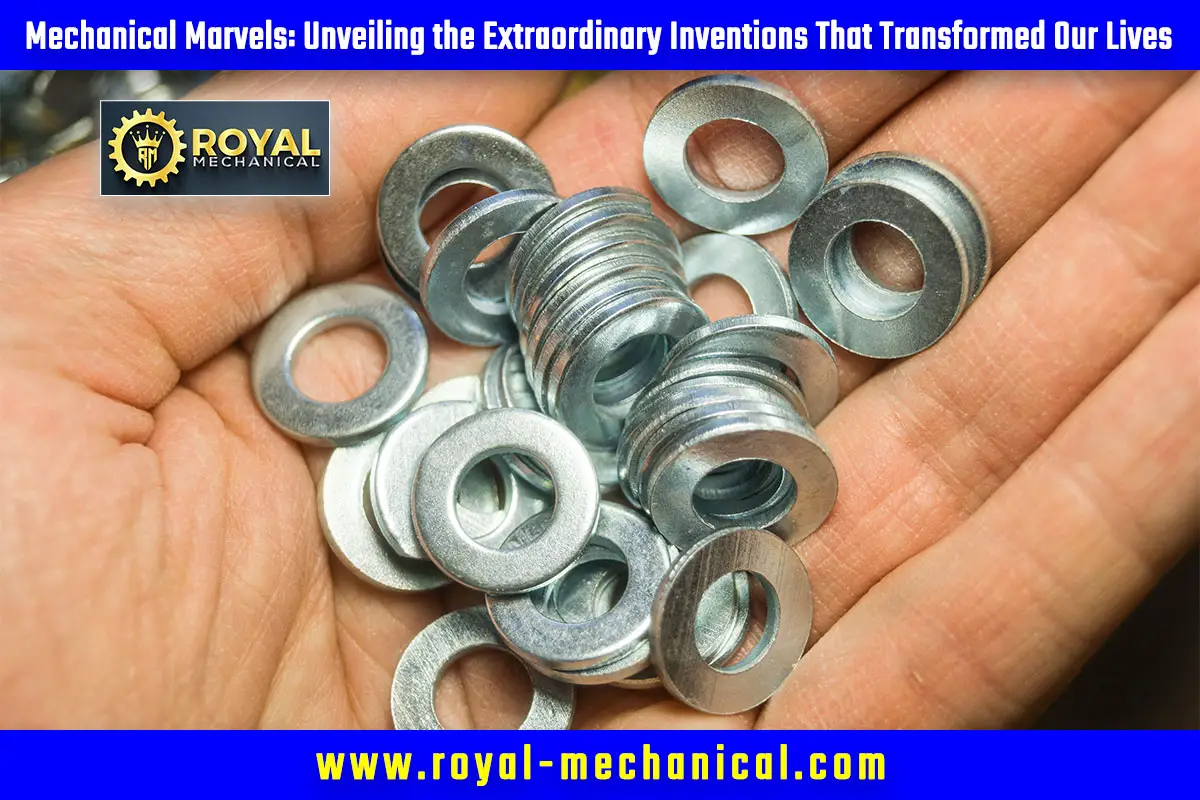
Introduction
Washers are seemingly simple components that often go unnoticed. Still, their significance in various mechanical and construction applications cannot be overstated. These thin plates with a hole play a crucial role in distributing the load of threaded fasteners, such as bolts and nuts. In this article, we will delve into the world of washers, exploring their different types, functions, and the reasons behind their widespread use across industries. From their historical origins to modern-day applications, we will uncover these unsung engineering heroes’ hidden value and versatility.
Table of Contents
Computer-Aided Design of a Washer
History of Washers
The use of washers can be traced back to ancient times when simple circular discs made from wood, leather, or metal were utilized to enhance the stability and effectiveness of fastening mechanisms. Over the years, washers evolved in design and materials, with advancements in metalworking techniques enabling the production of more precise and durable variants. The industrial revolution marked a turning point for washers as manufacturing processes improved, allowing for mass production and standardization. Today, washers are essential in every industry, including automotive, construction, aerospace, and more.
Types of Washers
Washers come in various shapes and sizes, each designed to meet specific needs and requirements. The most commonly used types of washers include plain, spring, lock, and flat. Plain washers, or flat washers, are the simplest form, offering a smooth surface and distributing loads evenly. On the other hand, spring washers are designed to provide tension, helping to prevent loosening or loss of preload in applications subject to vibration or dynamic forces. Lock washers, including split and toothed, add security by creating friction between the fastener and the mating surface. These washers are often used in high-vibration environments.
Function and Benefits
The primary function of washers is to distribute a load of a threaded fastener over a larger area, reducing stress and preventing damage to the fastened materials. By creating a larger surface contact area, washers can increase the clamping force, thereby improving the integrity and reliability of the joint. They also act as spacers, compensating for irregularities or gaps between components, ensuring a tight and secure fit.
Washers are crucial in preventing damage to delicate or brittle materials by exerting even pressure and reducing the risk of cracking or deformation. They also act as insulators, preventing galvanic corrosion by separating dissimilar metals. Additionally, washers help reduce friction and wear between fasteners and the surfaces they are in contact with, thereby prolonging the assembly’s lifespan.
Applications
Washers find applications in a wide range of industries. In the automotive sector, they are used in engines, transmissions, suspension systems, and body assemblies. In construction, washers are crucial for securing structural components, fastening joints, and distributing loads in buildings and bridges. The aerospace industry relies on washers for critical connections that require precision and durability. Washers are also extensively used in manufacturing appliances, furniture, machinery, and electrical equipment, among many other applications.
Innovations and Future Developments
As technology continues to advance, so do washer designs. Today, specialized washers cater to specific requirements, such as high-temperature environments, corrosive atmospheres, or extreme load conditions. Manufacturers are exploring new materials, such as stainless steel, titanium, and various polymers, to improve performance and increase longevity. Additionally, there is a growing interest in eco-friendly washers, with research focused on developing biodegradable or recyclable materials to reduce environmental impact.
Conclusion
While often overlooked, washers are indispensable components in various industries, ensuring assemblies’ integrity, stability, and reliability. Their ability to distribute loads, prevent damage, and provide added security makes them essential to threaded fastening systems. As technology evolves, so will washer designs, introducing new materials and specialized variants to meet the diverse demands of different applications. The next time you encounter a bolt or nut, take a moment to appreciate the unsung hero supporting the connection—the washer.
How to Select a Washer?
Choosing a suitable washer is crucial for ensuring the effectiveness and longevity of a fastening system. Consider the following factors when selecting a washer:
a. Material:
The material of the washer should be compatible with the materials being fastened. Standard options include steel, stainless steel, brass, and nylon. Stainless steel washers are corrosion-resistant, while nylon washers are non-conductive and suitable for electrical applications.
b. Size and Shape:
Washers come in different sizes and shapes to accommodate various fastener dimensions. Ensure that the washer’s inner diameter matches the outer diameter of the fastener. In contrast, the outer diameter fits within the assembly’s available space.
c. Load and Application:
Assess the load requirements of the application. If the joint is subjected to vibration or dynamic forces, consider using spring washers or lock washers to provide additional tension and prevent loosening. For high-stress applications, thicker or larger washers may be necessary to distribute the load effectively.
d. Environmental Factors:
Consider the environmental conditions the washer will be exposed to. For instance, stainless steel or coated washers are preferred in corrosive atmospheres to enhance durability. Materials with high-temperature resistance, such as heat-treated steel or ceramic washers, should be considered in high-temperature environments.
e. Standards and Regulations:
Depending on the industry and application, specific standards and regulations may dictate the type of washer used. To ensure compliance, consult relevant guidelines, such as those provided by organizations like the American Society for Testing and Materials (ASTM) or the International Organization for Standardization (ISO).
f. Supplier Reliability:
Selecting a reputable and reliable supplier ensures the availability of quality washers. Consider suppliers that offer a wide range of washer options, provide product certifications, and have a track record of delivering on time.
Considering these factors, you can make an informed decision and select the most suitable washer for your specific application, ensuring optimal performance and reliability.
Conclusion
Selecting the suitable washer involves considering material compatibility, size, load requirements, environmental factors, and adherence to standards and regulations. Taking the time to assess these factors will help ensure that the chosen washer provides the necessary functionality, durability, and reliability for your specific application. Remember to rely on reputable suppliers and consult relevant guidelines to make an informed decision. By selecting the appropriate washer, you can enhance the effectiveness of your fastening system and contribute to your assemblies’ overall performance and longevity.
How to Design a Washer?
Designing a washer requires careful consideration of various factors to ensure its effectiveness and functionality. While the design process may vary depending on specific applications and requirements, here are some general steps to guide you:
Determine the application requirements:
Understand the purpose of the washer, the loads it will experience, and the materials being fastened. Consider load distribution, material compatibility, space constraints, and environmental conditions.
Select the washer type:
Choose the appropriate kind based on the application’s needs. Consider factors such as the need for load distribution (plain washer), tension and vibration resistance (spring washer), or added security (lock washer).
Calculate dimensions:
Determine the optimal dimensions of the washer based on factors like the outer and inner diameter, thickness, and shape. Consider the dimensions of the fastener, the assembly components, and the desired load distribution.
Material selection:
Choose a suitable material based on load-bearing capacity, corrosion resistance, temperature tolerance, and electrical conductivity requirements. Consider options like steel, stainless steel, brass, or specialized polymers.
Evaluate stress distribution:
Use engineering principles to assess the stress distribution across the washer. Analyze factors like contact pressure, bending moments, and shear forces to ensure the washer can withstand the expected loads without deformation or failure.
Prototype and testing:
Create a prototype of the designed washer and subject it to testing. Evaluate its performance under simulated conditions, such as load testing, vibration testing, or exposure to specific environments. Modify the design if necessary based on the test results.
Documentation and standard compliance: Ensure the washer design complies with relevant standards and regulations. For future reference, document the design specifications, including dimensions, material specifications, and performance characteristics.
Supplier selection:
Identify reputable suppliers who manufacture the washer according to the design specifications. Consider their manufacturing capabilities, quality control processes, and ability to meet your requirements.
By following these steps and incorporating engineering principles, you can design a washer that meets the functional needs of your application, ensuring optimal performance, reliability, and safety.
Conclusion
Designing a washer involves considering application requirements, washer type selection, dimensions, material choice, stress distribution, testing, and compliance with standards. Engineers can create washers that effectively distribute loads, enhance joint integrity, and stabilize fastening systems by following a systematic design process. Collaborating with experienced suppliers and conducting thorough testing can further refine the design and ensure the washer’s suitability for the intended application. A well-designed washer contributes to the overall performance, longevity, and safety of assemblies in various industries.
How Are Washers Manufactured?
The manufacturing process of washers involves several steps to transform raw materials into finished products. While specific techniques may vary depending on the washer type and material, here is a general overview of how washers are manufactured:
Material selection:
The manufacturing process begins with selecting the appropriate material based on the desired properties of the washer. Common materials include steel, stainless steel, brass, nylon, or specialized polymers.
Material preparation:
The selected material is prepared by cutting it into appropriate sizes, such as sheets or coils, depending on the manufacturing method and the desired washer dimensions.
Washer blank production:
The prepared material is fed into a blanking press, which cuts the material into flat discs or washers of the desired shape and size. The press may use tooling such as dies to create washers with specific inner and outer diameters.
Forming and shaping:
Depending on the washer type, other forming processes may be employed. For example, spring washers undergo forming operations such as coiling or stamping to create the required shape and tension properties.
Heat treatment (if required):
Specific washers, such as hardened or spring, may undergo heat treatment to enhance their mechanical properties. This involves subjecting the washers to controlled heating and cooling cycles to achieve the desired hardness, strength, or spring characteristics.
Surface treatment (if required):
Some washers may undergo surface treatment to improve corrosion resistance or provide a specific finish. This can include coating the washers with zinc plating, nickel plating, or other protective coatings.
Quality control:
Throughout manufacturing, rigorous quality control measures are implemented to ensure the washers meet specified dimensional tolerances, material properties, and performance requirements. This can involve inspections, testing, and sampling.
Packaging and distribution:
Once the washers pass quality control checks, they are packaged and prepared for distribution. This can involve bulk packaging for industrial customers or retail packaging for consumer markets.
It’s important to note that the manufacturing process can vary depending on the washer type, material, and production scale. Advanced manufacturing technologies, such as CNC machining or specialized forming techniques, may be employed for more complex or custom washers.
Conclusion
The manufacturing of washers involves selecting suitable materials, preparing the raw materials, cutting and shaping the washers, and applying different processes such as heat treatment or surface treatment. Quality control measures are implemented throughout manufacturing to ensure that the washers meet specified standards and requirements. By employing advanced manufacturing techniques and adhering to strict quality control protocols, manufacturers produce washers that are reliable, durable, and capable of meeting the diverse needs of various industries.
FAQs: Washers
What is the purpose of a washer?
Washers are used to distribute the load of a threaded fastener, such as a bolt or nut, over a larger surface area. They help prevent damage to the fastened materials, increase clamping force, and provide stability to the joint.
How does a washer distribute the load of a threaded fastener?
By creating a larger contact area between the fastener and the surface, washers spread the load more evenly. This reduces stress on the materials and helps prevent joint deformation, cracking, or failure.
What are the different types of washers?
Common types of washers include plain (flat washers), spring washers, lock washers (such as split and toothed washers), and flat washers.
What is the difference between plain washers and spring washers?
Plain washers are flat, smooth discs that distribute loads evenly. On the other hand, spring washers are designed to provide tension, helping to prevent loosening or loss of preload in applications subject to vibration or dynamic forces.
When should I use lock washers?
Lock washers, split and toothed, are used when additional security is needed to prevent loosening or backing out of fasteners due to vibration or other external forces.
Can washers prevent the loosening of fasteners?
Yes, certain types of washers, such as spring washers and lock washers, are specifically designed to provide tension and help prevent the loosening of fasteners.
Are washers necessary for all types of fasteners?
While washers are not always required, they are commonly used in most applications to enhance the effectiveness and reliability of fastened joints. The need for washers depends on load requirements, material compatibility, and joint stability.
How do washers prevent damage to materials being fastened?
Washers distribute the load over a larger area, reducing the stress concentration on fastened materials. This helps prevent damage, such as deformation, cracking, or surface indentation.
Can washers compensate for irregularities or gaps between components?
Yes, washers can act as spacers, compensating for irregularities or gaps between components. They help ensure a tight and secure fit by filling the space and providing even pressure distribution.
Do washers act as insulators between dissimilar metals?
Yes, washers made from insulating materials like nylon can act as insulators between dissimilar metals. They prevent galvanic corrosion when two different metals come into direct contact.
Can washers reduce friction and wear between fasteners and surfaces?
Yes, washers can help reduce friction and wear by acting as a buffer between the fastener and the surface. This prolongs the lifespan of the assembly and promotes smooth movement.
What industries commonly use washers?
Washers are used in various industries, including automotive, construction, aerospace, manufacturing, appliances, furniture, machinery, and electrical equipment.
What materials are washers made of?
Washers can be made from different materials, including steel, stainless steel, brass, nylon, and various polymers. The choice of material depends on factors such as load requirements, environmental conditions, and compatibility with the fastened materials.
Are there eco-friendly washer options available?
Yes, there is a growing interest in developing eco-friendly washers. Researchers are exploring biodegradable or recyclable materials to reduce the environmental impact.
How do I select a suitable washer for my application?
Consider material compatibility, size, load requirements, environmental conditions, and adherence to relevant standards and regulations. Consulting with suppliers or referring to industry guidelines can help select the appropriate washer.
What considerations should I keep in mind when choosing a washer material?
Consider factors such as compatibility with the fastened materials, environmental conditions (e.g., corrosion resistance), temperature requirements, electrical conductivity, and load-bearing capacity.
Are there specific standards or regulations to follow when using washers?
Specific standards and regulations may exist depending on the industry and application. Examples include ASTM standards for material specifications and ISO standards for dimensional and performance requirements. Consult relevant guidelines for your specific application.
Can washers withstand high temperatures or corrosive environments?
Certain washer materials, such as stainless steel or specific alloys, are designed to withstand high temperatures and resist corrosion. Consider selecting materials suitable for specific environmental conditions.
Are there specific maintenance or care instructions for washers?
Washers typically require minimal maintenance. However, ensuring they are clean, debris-free, and in good condition during installation is essential. Regular inspections and replacements may be necessary if wear or damage is observed.
Where can I find reputable suppliers for washers?
Reputable suppliers of washers can be found through various channels, including online industrial suppliers, local hardware stores, and specialized fastener distributors. Research and consider suppliers with a track record of delivering quality products and meeting industry standards.





